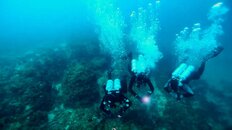Just to clarify (and not to take away from your point about discussing kit and procedures before the dive), I'm not using the 5' vs. 7' just because I have a short torso. Rather, I had understood it to be an acceptable/typical length for a "long" hose in OW diving. It doesn't route down under a can light or into my waistband like a 7' hose would.
This is not to say that I would not use a 7' house for OW diving. I bought the 5' house to try out when the "standard" hose configuration was proving to be uncomfortable, and I do like the 5' house/routing much better. I also think the air-share options seem good.
One note is that for me, currently, a knee problem is making it so that upon return to the boat, I doff my kit in the water and hand it up to the DM on the boat. Although I do clip the primary second stage off to a D-ring for the hand-up, there is still a fair "loop" present to dangle around during that move. In that case I'm glad it's not two feet longer (but, granted, that's a special case).
At any rate, I digress

I really just wanted to say that I chose the 5' hose after reading that it was an acceptable (and even "normal") "long" hose length for OW diving. I have only done air-sharing drills with my dive buddy (no "real" ones), and for that it has seemed really nice; but then we are comparing to when we do them the opposite way, and I'm using my buddy's "standard" octo, which is considerably shorter.
Blue Sparkle
PS: I will say that on my last trip, we switched hoses and my buddy used my 5' hose plus bungied backup (22"). He's not exactly weedy, and the 5' hose was too short for him, as was the 22" backup. It worked, but would be too cramped for regular use. I think if he were to want to use an "OW length" long hose it would need to be 6' -- and maybe a "long long" hose would need to be more than 7'? I guess that would have to be ascertained through trial.
I was reminded why I switched away from the "standard" set up: Not only was the primary reg constantly being pushed over to the left side of my mouth, but the primary hose "U" loop out to my right side was alternately banging into my buddy or getting caught in openings (wreck). If not using a "long" hose, I've also seen some photos of people routing a shorter primary hose down under their arm and then up, with a swivel at the end to avoid the "U." But that is a different setup of course.



 "So I had to buy all new equipment", :shocked2:
"So I had to buy all new equipment", :shocked2: 

